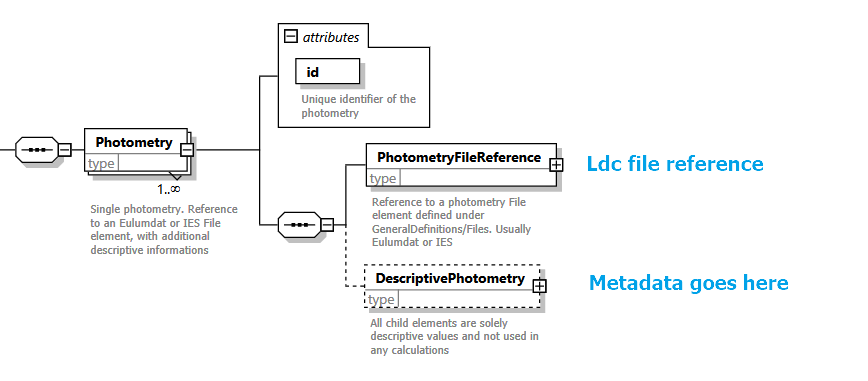Photometries
Photometry Description
Photometries is the third child-element of GeneralDefinitions - the part in the XML where global and reusable elements are defined (imagine them as the building blocks of each luminaire). Probably most GLDF will contain one or more photometries. However, the definition of photometries is optional.
First of all, a single Photometry element references a File element which describes the location of the ldc file (.ies/.ldt) itself. Furthermore, the Photometry element can contain various additional metadata to complement the ldc file.
Location in XSD

XSD description

XML example
<?xml version="1.0" encoding="UTF-8"?>
<Root xmlns:xsi="http://www.w3.org/2001/XMLSchema-instance"
xsi:noNamespaceSchemaLocation="https://gldf.io/xsd/gldf/1.0.0-rc.3/gldf.xsd">
<Header/>
<GeneralDefinitions>
<Files>
<File id="photometryFile" contentType="ldc/ies" type="localFileName">photometryFileName.ldt</File>
</Files>
<Photometries>
<Photometry id="photometry1">
<PhotometryFileReference fileId="photometryFile" />
</Photometry>
</Photometries>
</GeneralDefinitions>
<ProductDefinitions/>
</Root>
The Photometry Element above describes a single photometry with only mandatory content. It...
- references itself the ldc
Fileelement withidphotometryFile (line 6 + 10) - can be referenced in subsequent elements via photometry1 (its
idattribute, line 9) - provides no optional metadata (see below)
Its simply the definition of a ldc file as a photometry for further usage in the description of a luminare.
Referencing a photometry
Once declared, all photometries can be referenced in subsequent XML elements via their id attribute one or several times.
<?xml version="1.0" encoding="UTF-8"?>
<Root xmlns:xsi="http://www.w3.org/2001/XMLSchema-instance"
xsi:noNamespaceSchemaLocation="https://gldf.io/xsd/gldf/1.0.0-rc.3/gldf.xsd">
<Header/>
<GeneralDefinitions>
<Files>
<File id="photometryFile" contentType="ldc/ies" type="localFileName">MyLightSource_50W-E27.ldt</File>
</Files>
<Photometries>
<Photometry id="photometry1">
<PhotometryFileReference fileId="photometryFile" />
</Photometry>
</Photometries>
<LightSources>
<ChangeableLightSource id="lightSource1">
<Name>
<Locale language="en">My LightSource 50W E27</Locale>
</Name>
<RatedInputPower>50</RatedInputPower>
<RatedLuminousFlux>400</RatedLuminousFlux>
<PhotometryReference photometryId="photometry1"/>
</ChangeableLightSource>
</LightSources>
</GeneralDefinitions>
<ProductDefinitions/>
</Root>
The Photometry with id photometry1 (line 9) is referenced once inside the subsequent element ChangeableLightSource and defines the light source's light distribution curve (line 20).
Photometry MetaData
It is possible to optionally specify various metadata inside a photometry element to complement the content of the somewhat limited ldc file formats like IES and Eulumdat.
<?xml version="1.0" encoding="UTF-8"?>
<Root xmlns:xsi="http://www.w3.org/2001/XMLSchema-instance"
xsi:noNamespaceSchemaLocation="https://gldf.io/xsd/gldf/1.0.0-rc.3/gldf.xsd">
<Header/>
<GeneralDefinitions>
<Files>
<File id="photometryFile" contentType="ldc/ies" type="localFileName">photometryFileName.ldt</File>
</Files>
<Photometries>
<Photometry id="photometry1">
<PhotometryFileReference fileId="photometryFile" />
<DescriptivePhotometry>
<LuminaireLuminance>100</LuminaireLuminance>
<LightOutputRatio>0.5</LightOutputRatio>
<LuminousEfficacy>0.5</LuminousEfficacy>
<DownwardFluxFraction>0.5</DownwardFluxFraction>
<DownwardLightOutputRatio>0.5</DownwardLightOutputRatio>
<UpwardLightOutputRatio>0.5</UpwardLightOutputRatio>
<TenthPeakDivergence>
<C0-C180>100</C0-C180>
<C90-C270>100</C90-C270>
</TenthPeakDivergence>
<HalfPeakDivergence>
<C0-C180>100</C0-C180>
<C90-C270>100</C90-C270>
</HalfPeakDivergence>
<PhotometricCode>830/359</PhotometricCode>
<CIE-FluxCode>69 98 100 100 65</CIE-FluxCode>
<CutOffAngle>100</CutOffAngle>
<UGR-4H8H-70-50-20-LQ>
<X>100</X>
<Y>100</Y>
</UGR-4H8H-70-50-20-LQ>
<IESNA-LightDistributionDefinition>Type V Circular</IESNA-LightDistributionDefinition>
<LightDistributionBUG-Rating>LZ1</LightDistributionBUG-Rating>
</DescriptivePhotometry>
</Photometry>
</Photometries>
</GeneralDefinitions>
<ProductDefinitions/>
</Root>
- LuminaireLuminance
Average luminance of the luminous surface (Unit: cd/m²). See also EN 13032-1:2012 - LightOutputRatio
Ratio of the luminous flux of the luminaire to the sum of the individual luminous fluxes of its conventional light source(s). According to EN 12665:2018 - LuminousEfficacy
Quotient of the luminous flux emitted by the luminaire and the power absorbed by the light source and associated circuits of the luminaire - DownwardFluxFraction
Ratio of the downward flux to the total flux of the luminaire - DownwardLightOutputRatio
Ratio of the downward luminous flux of the luminaire to the sum of the individual luminous fluxes of the its light source(s). Not valid for absolute photometry - UpwardLightOutputRatio
Ratio of the upward luminous flux of the luminaire to the sum of the individual luminous fluxes of the its light source(s). Not valid for absolute photometry - TenthPeakDivergence
Angle of the beam center to the point where the luminous intensity is reduced to one tenth. See also EN 61341:Ed.2 - HalfPeakDivergence
Angle of the beam center to the point where the luminous intensity is reduced to half. See also EN 61341:Ed.2 - PhotometricCode
Photometric code consists out of CRI, CCT, initial color variation (MacAdam ellipse steps), color variation through life (MacAdam ellipse steps) and lumen maintenance value (Lx). E.g. 830/359 - CIE-FluxCode
Set of values: flux triplet, downward flux fraction and light output ratio - CutOffAngle
Angle, measured up from nadir, between the vertical axis and the first line of sight at which the light sources and the surfaces of high luminance are not visible - UGR-4H8H-70-50-20-LQ
UGR table value of a 4H8H room and degrees of reflection 70/50/20 - IESNA-LightDistributionDefinition
US-Types of luminaire light distribution according to IESNA for street lighting. Please note: These types are used in IES photometry files - LightDistributionBUG-Rating
Backlight, Uplight and Glare known as BUG classification. According to IDA/IESNA BUG evaluates the light output of outdoor lights regarding to glare, light pollution and light trespass